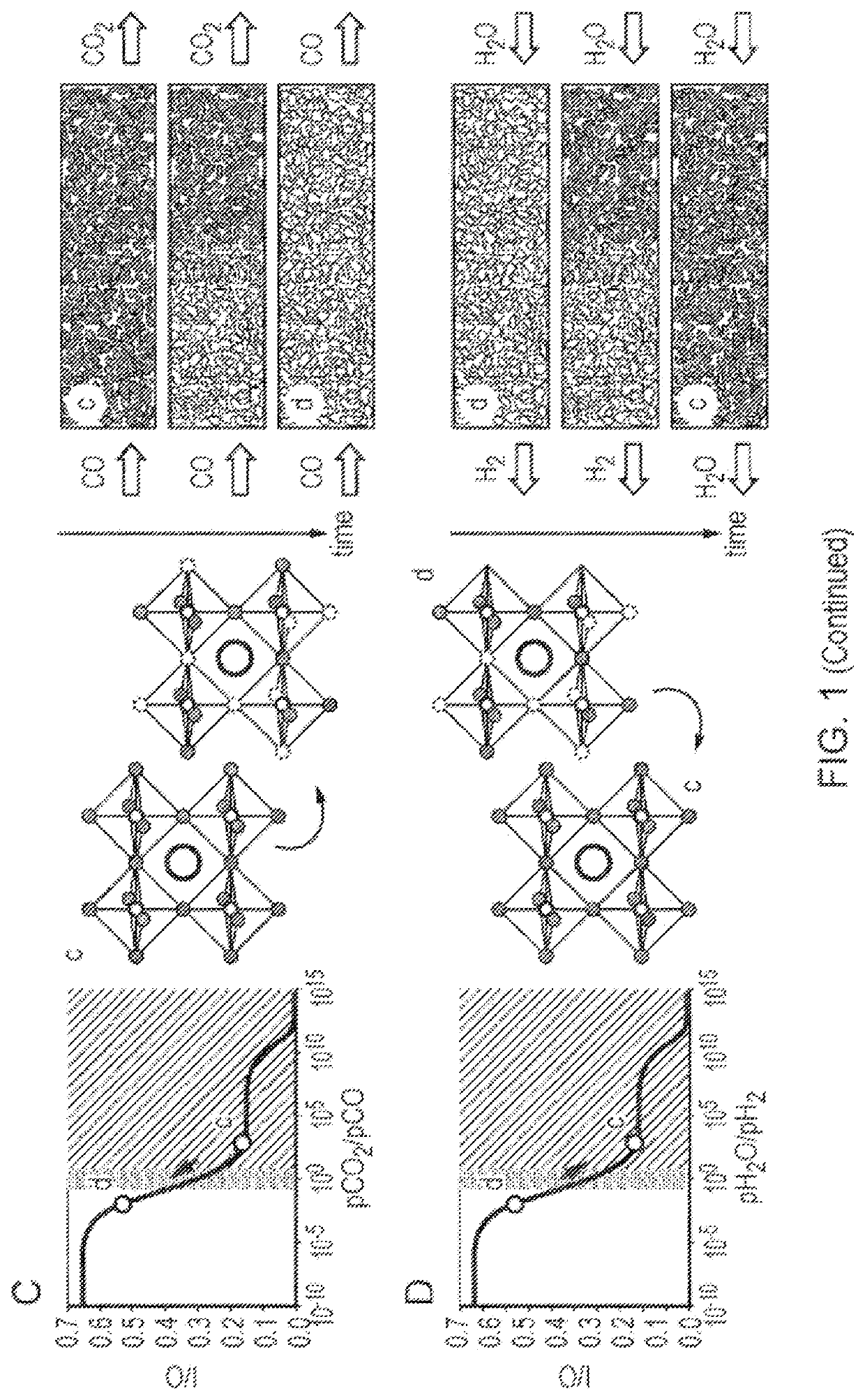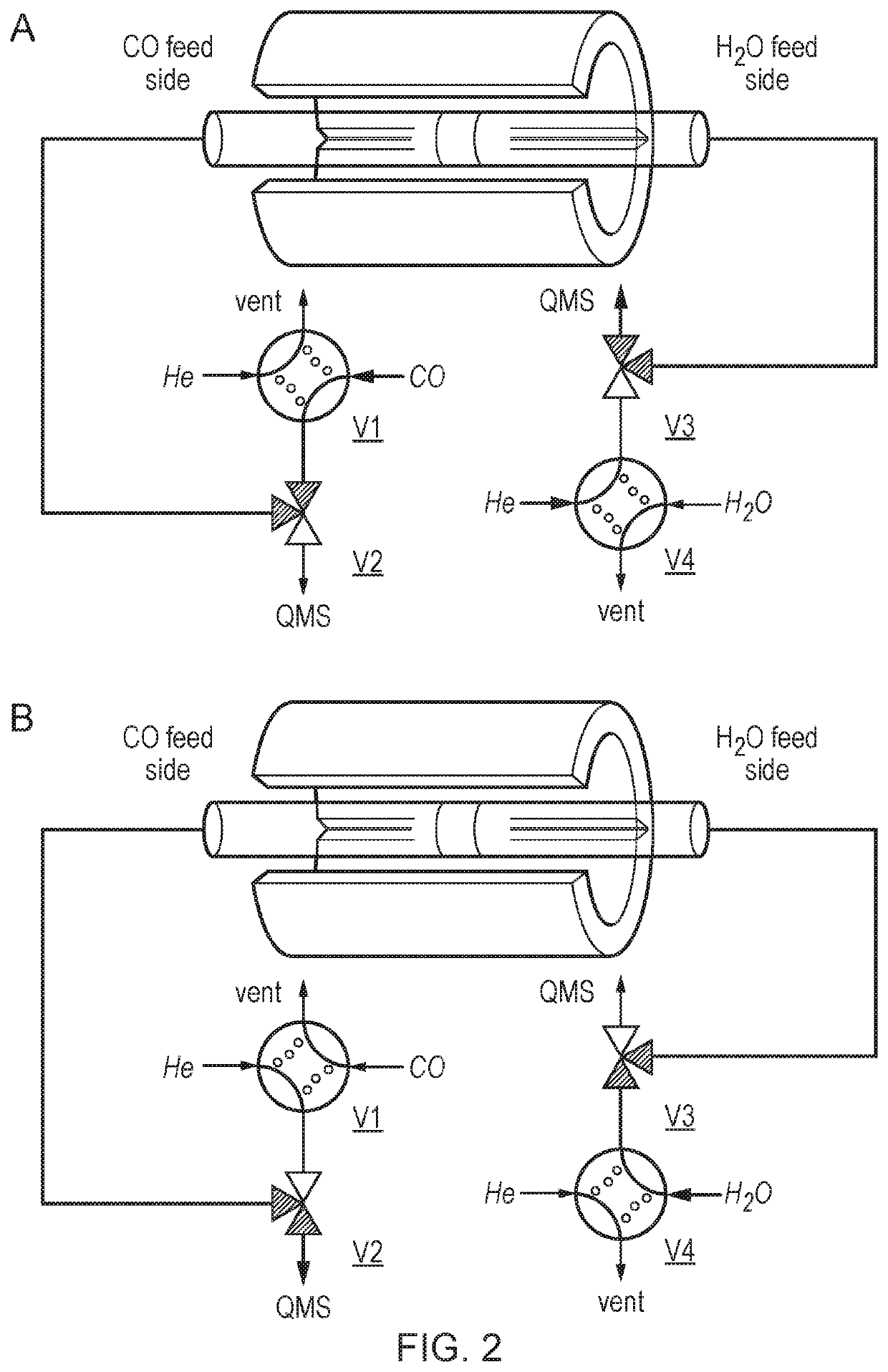Chemical looping
a looping and chemical technology, applied in the field of chemical looping, can solve the problems of complex separation process, waste of reactants, incomplete conversion of reactants, etc., and achieve the effect of avoiding the need for energy-consuming and costly processes
- Summary
- Abstract
- Description
- Claims
- Application Information
AI Technical Summary
Benefits of technology
Problems solved by technology
Method used
Image
Examples
example 1
Thermodynamic Analysis
[0124]Carbon monoxide and water are mixed and fed to a conventional reactor where the water-gas shift reaction occurs,
CO+H2O↔CO2+H2 (S1)
[0125]If the reaction kinetics are fast enough that the gases equilibrate then,
[0126]1K(pCO2pCO)outlet=(pH2OpH2)outlet(S2)
where the reactor partial pressures, pi ,evaluated at the outlet are governed by the equilibrium relationship for the water-gas shift reaction.
[0127]In the case of the water-gas shift reaction performed by chemical looping the reaction scheme would involve:
CO+O(OCM)→CO2 (S3)
H2O→H2+O(OCM) (S4)
where O(OCM) is oxygen associated with the oxygen-carrier material. Separate streams of hydrogen (in water) and carbon dioxide (in carbon monoxide) are produced.
[0128]In the case of an oxygen-carrier material which exhibits a single phase transition, the chemical looping reactor outlet partial pressures are governed by the equilibrium relationship,
[0129]1K(pCO2pCO)outlet=(pH2OpH2)outlet=1K(pCO2pCO)PT=(pH2OpH2...
example 2
Materials and Methods
[0135]The non-stoichiometric perovskite-type material lanthanum strontium ferrite (La0.7Sr0.3FeO3-δ or LSF) was used as an oxygen-carrier material. This material is non-stoichiometric with the equilibrium degree of non-stoichiometry, δ, determined by the water to hydrogen partial pressure ratio to which the material is exposed. The two reactions that control the degree of non-stoichiometry in the LSF are the oxidation and disproportionation of Fe(III) to Fe(II) and Fe(IV). Using Kröger-Vink notation these reactions can be written as,
[0136]VO••+2FeFe×+12O2↔OO×+2FeFe•(S9)2FeFe×↔FeFe•+FeFe / (S10)
[0137]And the equilibrium constants for these reactions can be defined as,
[0138]Kox=[OO×][FeFe•]2pO212[FeFe×]2δ(S11)KFe=[FeFe•][FeFe / ][FeFe×]2(S12)
where the square brackets refer to average number of species per unit cell. Rather than employ an oxygen partial pressure, a water to hydrogen partial pressure ratio that would be in equilibrium with that oxygen partial...
example 3
Differential Kinetics
[0152]Differential kinetic measurements were performed in a fully automated and programmable microreactor (CATLAB, Hiden Analytical Ltd., UK) with an integrated soft ionisation quadrupole mass spectrometer (QMS) (QIC-20 Bench-top Gas Analysis unit, Hiden Analytical Ltd., UK) at approximately 1 bar and the slightly higher temperature of 850° C. (FIG. S6). The reactor was operated in the main differentially, that is the conversion of reactants was low (less than 10% apart from when high initial rates of hydrogen production were encountered). The temperature of the sample was monitored and controlled by an internal K-type thermocouple inserted into an inert alumina sleeve. Initially, the fresh sample (˜50 mg) post calcination was placed in the reactor before flushing with a helium flow of 7.4×10−5 molts (100 ml (STP) / min) prior to commencing testing. After that, the oxygen-carrier material was subjected to isothermal reduction under 5 mol % carbon monoxide in heliu...
PUM
| Property | Measurement | Unit |
|---|---|---|
| temperature | aaaaa | aaaaa |
| temperatures | aaaaa | aaaaa |
| temperature | aaaaa | aaaaa |
Abstract
Description
Claims
Application Information
 Login to View More
Login to View More - R&D
- Intellectual Property
- Life Sciences
- Materials
- Tech Scout
- Unparalleled Data Quality
- Higher Quality Content
- 60% Fewer Hallucinations
Browse by: Latest US Patents, China's latest patents, Technical Efficacy Thesaurus, Application Domain, Technology Topic, Popular Technical Reports.
© 2025 PatSnap. All rights reserved.Legal|Privacy policy|Modern Slavery Act Transparency Statement|Sitemap|About US| Contact US: help@patsnap.com



